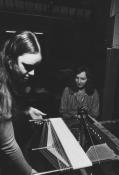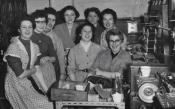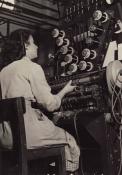Browse the interviews
Sorted by interview reference
VSW049 Monica Walters, Smiths Crisps, Fforestfach
Monica left school at 15 (1952) and went to work in Woolworth’s but within months was in Smiths’ Crisps. At first she stamped numbers on tins of crisps and stacked them for the lorries. Then she moved to boxing. Then they had a machine and she would take tins off the rollers, take packets off the trays and put lids on. Picking up so many packets of crisps wore her fingers down. Nurse examining fingers every morning. She had to do 800 tins a day for her wages + bonus for every hundred after. Upstairs they made the crisps – horrible smell. Very busy in summer, time dragged in winter. She wore a big thick apron for boxing work. Bonus and dinner Xmas time. Turban provided. Tins numbered. Music played and some workers jived. She left when she got married c.1957 – her husband disapproved. Teasing the men drivers. Annual trip. On her marriage they gave her a Westminster chime clock.VN050 Sandra Brockley, Shotton Steel Works, Shotton;De Haviland Aircraft Co, Broughton;Courtaulds, Flint
Beginning at Courtaulds in 1960, Sandra worked first on the perning, doing 'dolls hair' before being moved on to the 'cakes'. They were on piece work but she was never fast enough. The factory had a glass roof which was painted green to keep the sun out but they were still 'cooking', said Sandra, but it could also be very cold in winter. She lived four miles away and went to work on the bus. She also went on day release. She left after six years, when she about 21, because she was fed up. “I gave my notice in; it was time to leave, time to move on. I was thinking, no, I’m not going in today and I drove right past and went to Rhyl.” A little later she got a job with De Havilands driving a crane on the Hawker Sidley 125 production line (small planes): " My dad always talked about slingers, I knew what a slinger was and things like this. I knew the language, so that was it, I was a crane driver." She left this job after a year to have a baby, and returned to work in John Summers (Shotton Steel works), and doing various driving and sales jobs, from 1971 until she retired in 1998.VSE050 Audrey Gray, Johnson & Johnson, Pengam;British Nylon Spinners, Pontypool
Audrey left the grammar school (she describes her experiences in detail) at 17 (1953/4) and though destined for university her brothers’ weddings left her mother with no income and she went to work in the laboratory in BNS, testing yarns for viscosity etc. Keeping records and cleaning everything in the evening. Notes working with asbestos baths and fume cupboards when describing processes. Tested raw materials too e.g. water and coal. Girls didn’t work on the night shift. She understood the production process. She notes that girls’ schools didn’t have chemistry labs. Number of toxic and dangerous chemicals. Wore terylene lab coats, two strength gloves – gauntlets of rubber, eye-shields compulsory for some jobs, She had one accident - a flask bubbled up and shot solution into her face – first aiders, nurses and hospital. One walk out because hot and air conditioning not working. Social life with lab people mainly. Different clubs – tennis, table tennis, canoeing. Beautiful factory grounds. Laundry basket for their lab coats, dusters etc. Paid monthly. They were given shares and pensions. Seven day shift system. She belonged to the ASTMS union- Assoc. of Technical and Management ? With automation came redundancies. She describes the excellent social club and events. Xmas dances – responsibility of one shift, like a film set. She stayed there for 12-3 years and then to Johnson’s in the quality control lab for a few years. It produced j cloths.

VSW050 Beryl Jones, Avon Inflatables, Dafen;Hodges, Fforestfach
Beryl began working in Hodges in 1960/1 (until 1964) after leaving school at 15. She knocked on the door of the first factory she came to. They made men’s suits: men cut the material out and the girls sewed. She worked in the cutting room. She notes the importance of unionism in both factories, giving her mother her pay packet; the Swansea girls; the monkey parade. After marrying and bringing up the children she worked in Avon Inflatables from 1980 making dinghies. She describes the smell of glue and a complaint because she spoke Welsh. You learn about life in a factory. She left in 1990.VN051 Pat R.D., De Haviland Aircraft Co, Broughton
Pat began in De Havilands straight from school, in 1966, in the mail room, where she delivered post: “We had to go walking all round the factory with mail bags on us, and it was quite a nice little job. We knew every department in the factory.” Later she moved onto general office duties: “I went on to the Gestetner machines and I learnt a lot about printing. It was a job. To be honest, I didn’t know what I wanted. As I didn’t have any qualifications for anything.” She ended up in the Repair and Overhaul section: “That was great because all the planes came in to be serviced. The RAF was still there but quite a few came in from Switzerland, to be serviced.” She was often called upon to do other things, such as make up the weight they needed to during an aircraft flight, when she'd take her office work with her. She was there for ten years and then left to have her first child in 1976: “It wasn't like today, you couldn’t carry on after you had them, you had to leave; six months and you had to go.”VSE051 Jill Williams, Lewis & Tylor Ltd, Gripoly Mills
Jill left school at 16 (1968) and started in Lewis and Tylor. She found the noise unbelievable (electrical and manual looms) and cried at the thought of working there. She stayed there 10+ years. She also did home work repairing belts. She describes and explains the skilled work in great detail. Calluses on her hands – no gloves. It was like rowing. Caring – wedding gifts etc. One group made rubberised belts on smaller looms. The men made pipes and hoses for aeroplanes. After having the children she worked part-time there. The story about the foreman and his dog. Piecework and doing quota of belts. Some rushing and poor quality of belts. Describes bouncing up and down when weaving. Some dangers – tripping, weights falling, Helping one another. They all liked one particular loom – made better quality belts. She wanted to keep her own wires – during the holidays the foreman would wrap them up for her. Different patterns – plain, purl, herringbone etc. She took a record player into work. Her clocking-in number was 60. Trips and great fun. Later there were many Indian (Kenya) workers – TB a problem and the factory was closed for a time. Story of one arranged marriage. She worked as a dinner lady too – story of the bag of money. Her mother and father’s work. She shows the measure and the needles she had. Effect on hearing. Further details of technique.Part of this interview is available as an audio file

VSW051 Jean Evans, Mettoys, Fforestfach;John Stanton, Abertawe
Jean left school at 15 (1960) and worked in the Home and Colonial shop Swansea. After c.8 months she moved to Mettoys. Hard work, everything was weighed and she was paid according to what was in the pallets. Moved around – onto assembly making toys. She left when she had her boy but returned on evening shift after eight months. She was in the Fettling Dept., cleaning car parts. Then went on to inspecting, ready for packing. Reported sub-standard work. Then given more responsibility – in charge of others. Left because tired of evening work and landed up in John Stanton sewing factory. But returned in three weeks to Mettoys. Left then to work as a domestic. In Mettoys the manager did spot checks. The white coats were mostly men. She came out of her shell in the factory. They had fun.VN052 Enid Jones, Cwper Web, Bethesda;Ferranti, Bangor
Enid’s first job was making injaroc Number 8, which she got by way of her mother’s friend Mrs Morris. Mrs Morris had initially made the candy rock at home before selling the recipe to a local factory where she then went to work. After six months or so, she moved to Ferranti, an electronics factory, and was there for 14 years. She was on the meter testing for years, her main job, testing meters ready to go out to Manweb. The factory produced meters and also 'ear defenders' for the ears of pilots flying aeroplanes and other small things like that, there was a lot of engineering going on there. She said it was a lot of fun working there and she remembers a number of strikes too, over pay disputes or if a worker was sacked unfairly. She had to leave because she was expecting her first child in 1970, and she felt sad to leave. She would have liked to have returned to work but in those days, she said, there was no way to go back because you had no one to look after the baby.VSE052 Marjorie (Marge) Rita Evans, Welsh Trust, Rhigos;Sobells, Rhigos
Marjorie left school at 14 (1947) and started in Sobell’s. She started making one coil at a time and progressed to making 10 on the Westminster machine – dangerous because it was big and speedy. Whole TV sets including cabinets made there. When she went there they were making wirelesses and gramophones not TVs. Used Murphy factory’s nearby to make Sobell’s give them better bonuses. Until they got married she and her husband gave their pay to their mothers. She had an accident and no sick pay or compensation. Factories had a bad name, but she ‘loved it’. Men and women workers worked on line. Smell of wax, huge place with bays. She was asked to go to Welsh Trust to train workers on the big machines. The machines were ‘part of us.’ Though dangerous they didn’t like wearing turbans. Union – GMBU. She was a foreman for a while but then went back on machine. Dancing at weekends. Xmas dance in canteen. She stayed in Sobell’s for 12 years and worked in Welsh Trust for 5 years. She left when she had her son. In WT a smaller factory, winding coils for wirelesses and deaf aids. Couldn’t afford a TV when in Sobell's. Time and motion – she worked at a normal speed.


